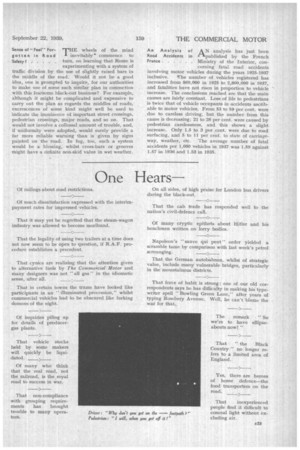Passing Comments
Page 26

Page 27

If you've noticed an error in this article please click here to report it so we can fix it.
Commercial Vehicles IT is rather amusing and Will Make History kinteresting to note that most Again of the smart goods and passen
ger vehicles are now pre-war I Joking apart, however, it is worth while pausing to wonder how many of those vehicles which are actively engaged in war work will " stand up to it." Many fine records were achieved by lorries and buses in the 1914-1918 horror; numbers of those warriors, in fact, are still going strong, and no doubt are ready to go to the front yet again. However, we think the modern product, although often mass produced, can give a pretty good account of itself.
Usefully Employing LARGE numbers of vehicles New Vehicles Being are being supplied to various Delivered . . . Government Departments by manufacturers, and the suggestion has been made to us that instead of letting these travel empty to their destinations, thus practically wasting fuel and drivers' time, they could be loaded with goods, etc., urgently required. The problem that appears to us to be somewhat difficult is as to who will receive payment for the conveyance of the loads, and whether the Government would be prepared to allow the use of its nice new vehicles for this purpose.
Sense of" Feel" ForHE wheels of the mind
gotten in Road I inevitably commence to Safety? turn, on learning that Rome is experimenting with a system of traffic division by the use of slightly raised bars in the middle of the road. Would it not be a good idea, one is prompted to inquire, for our authorities to make use of some such similar plan in connection with this fearsome black-out business? For example, although it might be complicated• and expensive to carry out the plan as regards the middles of roads, excrescences of some kind might well be used to indicate the imminence of important street crossings, pedestrian crossings, major roads, and so on. That would not involve a colossal amount of trouble, and, if uniformity were adopted, would surely provide a far more reliable warning than is given by signs painted on the road. In fog, too, such a system would be a blessing, whilst cross-bars or grooves might have a definite non-skid value in wet weather.
An Analysis of Nanalysis has just been
Road Accidents in published by the French France Ministry of the Interior, con cerning fatal road accidents involving motor vehicles during the years 1925-1937 inclusive. The number of vehicles registered has increased from 860,000 in 1925 to 2,800,000 in 1937, and fatalities have not risen in proportion to vehicle increase. The conclusions reached are that the main causes are fairly constant. Loss of life to pedestrians is twice that of vehicle occupants in accidents ascribable to motor vehicles. From 53 to 59 per cent. were due to careless driving, but the number from this cause is decreasing; 21 to 28 per cent, were caused by pedestrian carelessness, and this shows a slight increase. Only 1.5 to 3 per cent. were due to road surfacing, and 5 to 11 per cent, to state of carriageway, weather, etc. The average number of fatal accidents per 1,000 vehicles in 1937 was 1.59 against 1.57 in 1936 and 1.53 in 1935.




































































